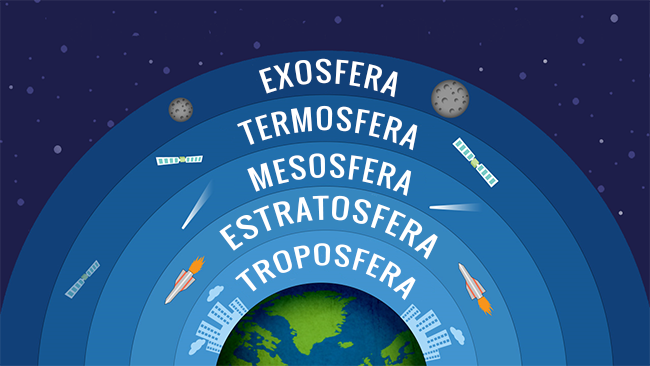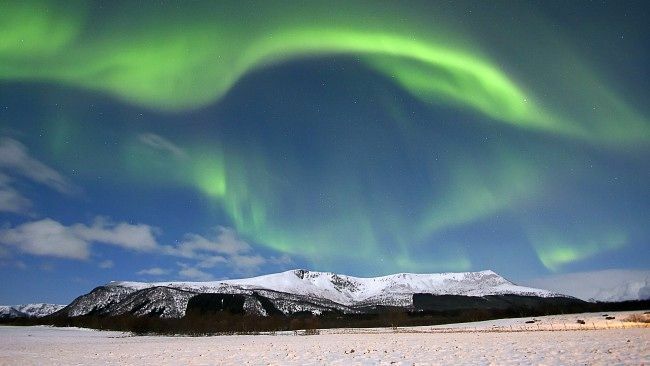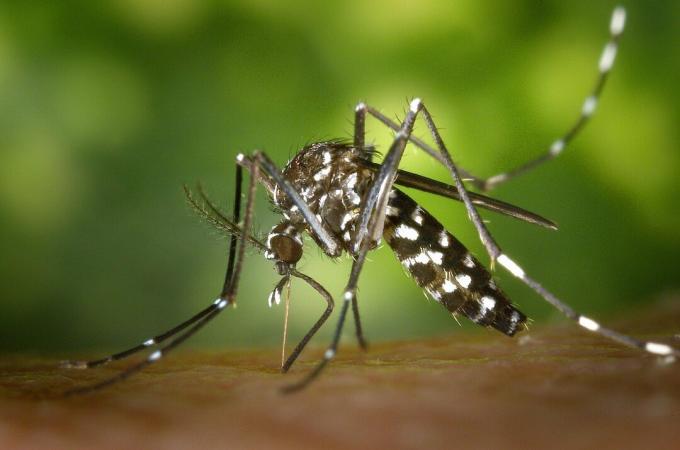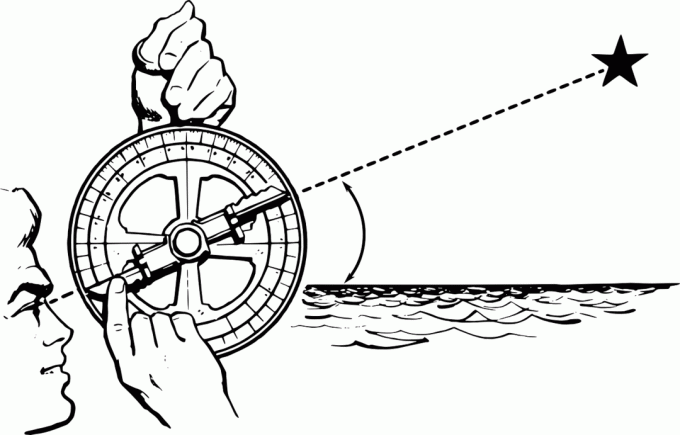The Earth's atmosphere is formed by several layers of gases that surround the Earth due to the effects of the gravitational field.
Each layer has a specific composition of gases that are organized according to their densities. The denser gases are pulled closer to the Earth's surface while the others remain further away from the planet.
Due to the different attributes that gases have, the layers of the atmosphere have their own characteristics and play specific roles in their relationship with the Earth.
At five layers that make up the earth's atmosphere are: troposphere, stratosphere, mesosphere, thermosphere and exosphere.

Troposphere
The troposphere is the densest layer of the atmosphere, and therefore the closest to the Earth's surface. It is estimated that the total atmospheric mass is 5x1018 kg, and that 75% of this amount is located in the troposphere.
The thickness of the troposphere varies from 8 km to 14 km, depending on the region of the Earth. The thinnest points (where the thickness reaches 8 km) are at the north and south poles.
As the lowest layer of the atmosphere, the troposphere is responsible for housing life on the planet, and it is also where almost all weather phenomena occur. The term troposphere is derived from the Greek tropes (change) to reflect the dynamic nature of climate change and the behavior of this layer of the atmosphere.
The region of the troposphere that delimits its end and the beginning of the stratosphere is called the tropopause. Tropopause is easily identifiable through the different pressure and temperature patterns of each layer.
troposphere composition
In terms of volume, the troposphere is composed of 78.08% nitrogen, 20.95% oxygen, 0.93% argon and 0.04% carbon dioxide. Air is also composed of a variable percentage of water vapor that enters the troposphere through the phenomenon of evaporation.
Troposphere temperature
Like pressure, temperature in the troposphere also decreases as altitude increases. This is because the ground absorbs most of the solar energy and heats the lower levels of the troposphere. Thus, considering that evaporation is greater in warmer areas, water vapors are more present at sea level and rarer at higher altitudes.
What can be found in the troposphere?
Some examples of what can be found in the troposphere are:
- Climate
- Precipitations such as rain, snow and hail;
- Gases such as nitrogen, oxygen, argon and carbon dioxide
- Clouds
- birds
Stratosphere
The stratosphere is the second largest layer of the atmosphere and also the second closest to the Earth's surface. It is estimated to contain about 15% of the total mass of Earth's atmosphere.
The thickness of the stratosphere is 35 km from the tropopause, meaning that it is located between the troposphere and the mesosphere. The term stratosphere is derived from the Greek stratum (layer), to designate the fact that the stratosphere itself is subdivided into other, smaller layers.
The layers of the stratosphere form due to the absence of climatic phenomena that mix the air. Thus, there is a clear division between cold, heavy air, which is located below, and warm, light air, which is located above. Thus, in terms of temperature, the stratosphere works in exactly the opposite way to the troposphere.
As it is a highly stable region (because there is no air exchange), airplane pilots tend to stay at the beginning of the stratosphere to avoid turbulence. It is at this altitude that planes and balloons reach their maximum efficiency.

Some aircraft, especially jet planes, climb into the stratosphere to avoid friction and air exchanges.
The stratosphere also contains the known ozone layer, responsible for absorbing most of the ultraviolet radiation emitted by the sun. Without the ozone layer, life on Earth as we know it would not be possible.
Like the troposphere, the stratosphere also has a region that delimits its end and marks the beginning of the mesosphere, called the stratopause.
composition of the stratosphere
Most elements found on the Earth's surface and in the troposphere do not reach the stratosphere. Instead, it is common for them to:
- decompose in the troposphere
- are eliminated by sunlight
- are brought back to the Earth's surface by rain or other precipitation
Because of the inversion in the temperature dynamics between the troposphere and the stratosphere, there is almost no exchange of air between the two layers, causing water vapors to exist only in minute amounts in the stratosphere. For this reason, cloud formation in this layer is extremely difficult.
With respect to gases, the stratosphere is predominantly formed by ozone present in the ozone layer. It is believed that 90% of all ozone in the atmosphere is found in this region. In addition, the stratosphere contains elements carried by volcanic eruptions such as nitrogen oxides, nitric acid, halogens, etc.
temperature in the stratosphere
The temperature in the stratosphere increases as altitude increases, ranging from -51°C at the lowest point (tropopause) to -3°C at the highest point (stratopause).
What can be found in the stratosphere?
Some examples of what can be found in the stratosphere are:
- Ozone layer
- Airplanes and weather balloons
- some birds
mesosphere
The mesosphere is the last atmospheric layer in which gases are still mixed in the air and not organized by their mass. It is considered by science the most difficult layer to study, so there is little confirmed information about it.
The thickness of the mesosphere is also 35 km, counted from the stratopause, meaning that it is located between the stratosphere and the thermosphere. The term mesosphere comes from the Greek months (middle), as it is the third among the five layers of the Earth's atmosphere
Weather balloons and aircraft are not capable of reaching so high as to reach the mesosphere. At the same time, satellites are only able to orbit above it so they cannot properly measure the characteristics of the layer. The only way to study the mesosphere, currently, is through the use of sonic rockets that collect little information per mission.
It is in the mesosphere that the combustion of celestial bodies that enter the Earth's atmosphere occurs, giving rise to phenomena such as meteor showers.

A meteor shower occurs when a celestial body enters the Earth's atmosphere. Due to the very high temperature, the celestial body combusts and usually dissolves into several smaller pieces.
composition of the mesosphere
The percentage of oxygen, nitrogen and carbon dioxide in the mesosphere is essentially the same as in the layers below. Water vapors are even rarer than in the stratosphere, which in turn transfers a portion of ozone to the mesosphere.
The mesosphere also contains material from meteors that vaporizes upon entering the atmosphere. Thus, the mesosphere is also composed of a relatively high proportion of iron and other metals.
temperature in the mesosphere
The temperature in the mesosphere decreases as altitude increases, ranging from -3°C at the lowest point (stratopause) and -143ºC at the highest point, the mesopause, the coldest region in the entire atmosphere terrestrial.
What can be found in the stratosphere?
Some examples of what can be found in the stratosphere are:
- Combusting meteors
- Noctilucent clouds (a special type of clouds that glow at night)
thermosphere
The thermosphere is located above the mesosphere and below the exosphere. Its thickness is approximately 513 km, which is much larger than all the lower layers combined.
Although the thermosphere is considered part of the Earth's atmosphere, the density of the air is so low that most of the layer is mistakenly seen as outer space. This idea is reinforced by the fact that the layer does not have enough molecules for sound waves to travel.
In the thermosphere, ultraviolet radiation causes the phenomena of photoionization of molecules, that is, the creation of ions through contact between a photon and an atom. This phenomenon is responsible for the creation of the ionosphere, located within the thermosphere. The ionosphere plays an important role in the propagation of radio waves to distant regions of the Earth.
It is in the thermosphere that the satellites and the International Space Station (ISS) orbit. Furthermore, it is in the thermosphere that the aurora borealis occurs.

The aurora borealis happens with the collision of solar particles with the Earth's atmospheric density.
The word thermosphere comes from the Greek thermos (heat), reflecting the fact that temperatures are extremely high in this layer.
The boundary between the thermosphere and the exosphere is called the thermopause.
Thermosphere composition
Unlike the layers below, in which gases mix, particles in the thermosphere rarely collide, resulting in an even division of elements. Furthermore, most of the molecules present in the thermosphere are broken down by sunlight.
The upper parts of the thermosphere are composed of atomic oxygen, atomic nitrogen and helium.
Thermosphere temperature
The temperature in the thermosphere can range from 500°C to 2000°C. This is because much of the sunlight is absurd in this layer.
What can be found in the thermosphere?
Some examples of what can be found in the thermosphere are:
- Satellites
- Previously, the space shuttle
- ISS
- Northern Lights
- Ionosphere
exosphere
The exosphere is the largest and outermost layer of the Earth's atmosphere. It stretches for 600 km until it thins and blends with interplanetary space. This makes its thickness to be 10000 km. The farthest boundary of the exosphere reaches halfway to the moon.
The term exosphere comes from the Greek exo (outer), marking the fact that this is the last atmospheric layer before the vacuum of space.
composition of the exosphere
Particles in the exosphere are extremely far apart and therefore are not classified as gases as the density is too low. It is possible for one particle to travel hundreds of kilometers before colliding with another. They are also not considered plasma as they are not electrically charged.
In the lower regions of the exosphere, it is possible to find hydrogen, helium, carbon dioxide and atomic oxygen, remaining minimally attached to the Earth by the gravitational field.
temperature in the exosphere
Due to the fact that the exosphere is almost vacuum (due to the absence of interaction between the molecules) the temperature in the layer is constant and cold.
What can be found in the exosphere?
Some examples of what can be found in the exosphere are:
- space telescope Hubble
- Satellites
See too:
- Atmosphere
- Troposphere
- Stratosphere
- Satellite
- Vacuum



